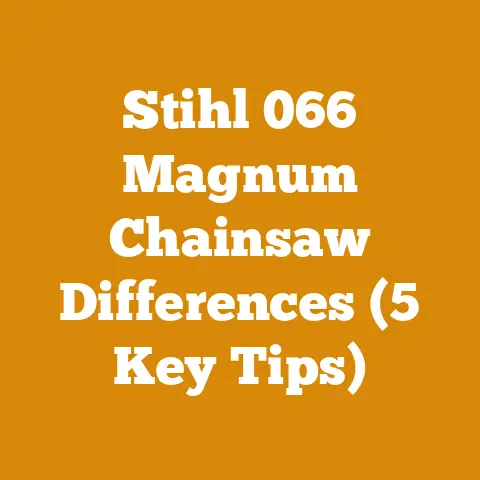Wood Mizer LT40 for Sale (5 Essential Tips for Value)
Sometimes, the best way to save money is to spend it. That sounds counterintuitive, especially when you’re eyeing a Wood-Mizer LT40 for sale. But trust me, after years in the logging and sawmill game, I’ve learned that a well-chosen investment can save you headaches and money in the long run. Let’s dive into the essentials of finding a good deal on a Wood-Mizer LT40.
Wood-Mizer LT40 for Sale: 5 Essential Tips for Value
The Wood-Mizer LT40 is a workhorse. I’ve seen them churning out board feet day after day, year after year. But like any machine, its value lies in its condition, features, and how well it fits your needs. Let’s break down how to find the best LT40 for your budget.
1. Know Your Needs Before You Look
Before you even start browsing classifieds, get clear on what you need the LT40 to do. This isn’t just about saying “I want to saw lumber.” It’s about specifics.
- Volume: How much lumber do you realistically need to produce per year? Are you a hobbyist sawing a few boards for personal projects, or are you planning to run a small commercial operation?
- Log Size: What’s the average diameter and length of the logs you’ll be sawing? The LT40 has limitations. Don’t buy one if you’re regularly dealing with oversized timber. The standard LT40 can handle logs up to 36 inches in diameter and lengths up to 21 feet.
- Lumber Types: What species of wood will you be milling? Hardwoods like oak and maple require more power and blade sharpness than softwoods like pine.
- Portability: Do you need a stationary mill, or will you be moving it to different locations? The LT40 is available in both stationary and trailer-mounted versions.
- Budget: Be honest with yourself about what you can afford. Don’t overextend yourself, but also don’t skimp on essential features if they will significantly improve your efficiency and the quality of your lumber.
I remember when I first started, I jumped at a “bargain” sawmill. It was cheap, but it couldn’t handle the hardwoods I wanted to mill. I ended up spending more time fixing it than sawing. Learn from my mistake.
Takeaway: Define your milling needs before you start shopping. This will help you narrow your search and avoid buying a mill that doesn’t meet your requirements.
2. Condition is King (and Queen!)
The condition of a used Wood-Mizer LT40 is the single most important factor determining its value. A well-maintained mill can last for decades, while a neglected one can become a money pit.
- Visual Inspection: Start with a thorough visual inspection. Look for signs of rust, corrosion, and damage. Pay close attention to the bed rails, head, and blade guides. Check for cracked welds or bent components.
- Hydraulics: The hydraulics are critical for log handling and leveling. Check for leaks, smooth operation of the cylinders, and proper pressure. Run the hydraulics through their full range of motion and listen for any unusual noises.
- Engine: Inspect the engine for leaks, excessive smoke, and unusual noises. Check the oil level and condition. Ask about the engine’s service history and whether it has been regularly maintained. Start the engine and let it run for a while to check for any problems. I prefer to use a compression tester and leak-down tester for a more accurate assessment.
- Blade and Blade Guides: The blade and blade guides are essential for accurate sawing. Check the blade for cracks, bends, and wear. Inspect the blade guides for damage and proper alignment. Ask about the blade’s history and how often it has been sharpened.
- Hours of Use: Ask about the total hours of use on the mill. While hours alone don’t tell the whole story, they can give you a general idea of the mill’s age and wear. More hours typically mean more wear and tear on the components.
- Test Cut: If possible, ask the seller to perform a test cut. This will allow you to assess the mill’s performance and accuracy. Check the lumber for straightness, consistent thickness, and smooth surface.
- Ask Questions: Don’t be afraid to ask the seller questions about the mill’s history, maintenance, and any known problems. A reputable seller will be honest and transparent about the mill’s condition.
I once inspected an LT40 that looked great in the photos. But when I got there, the engine was leaking oil, the hydraulics were sluggish, and the blade guides were worn out. A test cut revealed that the lumber was uneven and wavy. I walked away from that deal.
Takeaway: Thoroughly inspect the mill’s condition before making an offer. Pay close attention to the engine, hydraulics, blade, and blade guides. A test cut is essential to assess the mill’s performance.
3. Features That Add Value
Not all Wood-Mizer LT40s are created equal. Some come with features that can significantly increase their value and productivity.
- Hydraulics: Hydraulic log loaders, log turners, and toe rollers can save you a lot of time and effort. They make it easier to handle heavy logs and position them accurately on the bed.
- Computer Setworks: Computer setworks allow you to program the desired board thickness and automatically adjust the blade height. This improves accuracy and reduces waste.
- Debarker: A debarker removes the bark from the log before sawing. This helps to extend blade life and improve the quality of the lumber.
- Power Feed: Power feed automatically advances the saw head through the log. This reduces operator fatigue and improves sawing speed.
- Trailer Package: A trailer package makes it easy to transport the mill to different locations. This is essential if you plan to offer custom sawing services or mill lumber in remote areas.
- Extra Blades: A supply of extra blades is always a good thing to have. Blades can break or become dull, and having spares on hand will keep you from being sidelined.
- Sharpener: A blade sharpener allows you to sharpen your own blades, saving you money and ensuring that you always have sharp blades on hand.
When I upgraded to an LT40 with hydraulics and computer setworks, my production nearly doubled. The hydraulics made log handling much easier, and the setworks improved accuracy and reduced waste.
Takeaway: Consider the features that will improve your productivity and efficiency. Hydraulics, computer setworks, and a debarker can add significant value to the mill.
4. Research Market Prices
Before you make an offer on a Wood-Mizer LT40, do your research to determine the fair market value.
- Online Marketplaces: Check online marketplaces like Craigslist, eBay, and Forestry Forum for similar LT40s for sale. Compare the prices, condition, and features of the mills you find.
- Wood-Mizer Dealers: Contact Wood-Mizer dealers to inquire about used LT40s they may have in stock. Dealers typically offer warranties and service, which can provide peace of mind.
- Auction Sites: Check auction sites like IronPlanet and Ritchie Bros. for LT40s being sold at auction. Auctions can be a good way to find a deal, but be sure to inspect the mill thoroughly before bidding.
- Industry Contacts: Talk to other sawmill operators and loggers in your area to get their opinions on the fair market value of a used LT40. They may have firsthand knowledge of mills that are for sale or have recently been sold.
- Wood-Mizer Blue Book: Wood-Mizer may offer a “Blue Book” or similar guide that provides estimated values for used LT40s based on their age, condition, and features. Contact Wood-Mizer directly to inquire about this resource.
I once saw an LT40 advertised for $10,000 more than it was worth. The seller was hoping to take advantage of someone who didn’t know the market. Don’t be that person.
Takeaway: Research the market prices of similar LT40s before making an offer. Consider the mill’s condition, features, and location when determining its fair market value.
5. Negotiation Tactics That Work
Once you’ve found an LT40 that meets your needs and you’ve determined its fair market value, it’s time to negotiate the price.
- Be Prepared to Walk Away: The most powerful negotiating tool is the willingness to walk away from the deal. If the seller is unwilling to negotiate to a price that you’re comfortable with, be prepared to move on to another mill.
- Point Out Flaws: Don’t be afraid to point out any flaws or issues you find during your inspection. This can help you to justify a lower offer.
- Highlight Market Comparisons: Use your market research to justify your offer. Show the seller examples of similar LT40s that have sold for less.
- Offer Cash: Offering cash can be a powerful negotiating tool. Cash is immediate and certain, which can be attractive to sellers.
- Be Respectful: Even though you’re negotiating, it’s important to be respectful of the seller. A polite and professional approach can go a long way.
- Consider Financing: If you’re unable to pay cash, consider financing the purchase. This can allow you to spread the cost over time and make the mill more affordable.
- Get it in Writing: Once you’ve reached an agreement on the price, get it in writing. This will protect you from any misunderstandings or disputes later on.
I once negotiated the price of an LT40 down by $2,000 simply by pointing out a few minor repairs that needed to be made. The seller was motivated to sell, and he was willing to drop the price to close the deal.
Takeaway: Be prepared to negotiate the price of the LT40. Be willing to walk away, point out flaws, highlight market comparisons, and offer cash. Be respectful of the seller and get the agreement in writing.
Diving Deeper: LT40 Specifics and Considerations
Now that we’ve covered the general tips for finding value, let’s get into some specific details about the Wood-Mizer LT40.
LT40 Model Variations
The LT40 has been around for a while, and there are several variations of the model. Knowing the differences can help you make a more informed decision.
- LT40: The original LT40 is a solid, reliable mill. It’s a good option if you’re on a budget and don’t need all the bells and whistles.
- LT40HD: The LT40HD (Heavy Duty) features a heavier frame and more robust components. It’s designed for higher production and more demanding applications.
- LT40 Super: The LT40 Super offers increased power and capacity. It can handle larger logs and saw faster than the standard LT40.
- LT40 Wide: The LT40 Wide can accommodate wider logs than the standard LT40. This is useful if you’re working with oversized timber.
- Electric vs. Gas: The LT40 is available with either an electric or gas engine. Electric models are quieter and more environmentally friendly, but they require a reliable power source. Gas models are more portable and can be used in remote locations.
I personally prefer the LT40HD with a gas engine. The heavier frame provides more stability, and the gas engine gives me the freedom to mill lumber anywhere.
Takeaway: Understand the different LT40 model variations and choose the one that best meets your needs. Consider the power source, capacity, and features when making your decision.
Common LT40 Problems and How to Spot Them
Like any machine, the LT40 is prone to certain problems. Knowing what to look for can help you avoid buying a mill that’s going to require extensive repairs.
- Hydraulic Leaks: Hydraulic leaks are a common problem on older LT40s. Check all the hydraulic lines, cylinders, and valves for leaks. Look for signs of oil on the ground or around the components.
- Engine Problems: Engine problems can range from minor issues like a clogged air filter to major problems like a blown head gasket. Listen for unusual noises, check for excessive smoke, and inspect the oil level and condition.
- Blade Alignment Issues: Blade alignment issues can cause the lumber to be uneven or wavy. Check the blade guides for damage and proper alignment. Make sure the blade is properly tensioned and sharpened.
- Bed Rail Wear: The bed rails can wear over time, especially if the mill is used frequently. Check the bed rails for wear and damage. Make sure the log clamps are properly aligned and functioning.
- Electrical Issues: Electrical issues can cause a variety of problems, from the engine not starting to the setworks not functioning properly. Check the wiring for damage and corrosion. Make sure all the connections are tight.
I once bought an LT40 with a hydraulic leak that I didn’t notice during the inspection. I ended up spending several hundred dollars to repair the leak. Learn from my mistake and inspect the hydraulics carefully.
Takeaway: Be aware of the common LT40 problems and know how to spot them. Check the hydraulics, engine, blade alignment, bed rails, and electrical system carefully.
Maintenance Tips to Keep Your LT40 Running Smoothly
Once you’ve bought your Wood-Mizer LT40, it’s important to maintain it properly to keep it running smoothly and extend its lifespan.
- Regular Oil Changes: Change the engine oil regularly according to the manufacturer’s recommendations. Use the correct type of oil and filter.
- Grease Fittings: Grease all the grease fittings regularly. This will help to lubricate the moving parts and prevent wear.
- Sharpen Blades: Sharpen your blades regularly. Dull blades can cause the lumber to be uneven and wavy.
- Clean Air Filter: Clean the air filter regularly. A dirty air filter can restrict airflow and reduce engine performance.
- Inspect Hydraulic Lines: Inspect the hydraulic lines regularly for leaks and damage. Replace any damaged lines immediately.
- Check Blade Alignment: Check the blade alignment regularly. Make sure the blade guides are properly aligned and functioning.
- Store Properly: Store the mill properly when it’s not in use. Cover it to protect it from the elements.
I follow a strict maintenance schedule for my LT40. I change the oil every 100 hours, grease the fittings every week, and sharpen the blades as needed. This has helped me to keep my mill running smoothly for years.
Takeaway: Follow a regular maintenance schedule to keep your LT40 running smoothly. Change the oil, grease the fittings, sharpen the blades, clean the air filter, inspect the hydraulic lines, check the blade alignment, and store the mill properly.
The Business Side of Sawmilling with an LT40
Owning an LT40 isn’t just about sawing lumber for personal use. It can also be a viable business opportunity. Let’s explore some of the business aspects of owning and operating an LT40.
Determining Your Sawing Rates
If you plan to offer custom sawing services, you’ll need to determine your rates. Here are some factors to consider:
- Operating Costs: Calculate your operating costs, including fuel, blades, maintenance, and insurance.
- Labor Costs: If you have employees, factor in their wages and benefits.
- Market Rates: Research the market rates for custom sawing in your area.
- Complexity of the Job: Charge more for complex jobs that require more time and effort.
- Travel Costs: If you have to travel to the customer’s location, factor in your travel costs.
- Profit Margin: Add a profit margin to your rates to ensure that you’re making a reasonable profit.
I charge by the board foot, with a minimum charge for small jobs. I also charge extra for difficult logs or long distances.
Takeaway: Determine your sawing rates based on your operating costs, labor costs, market rates, complexity of the job, travel costs, and profit margin.
Marketing Your Sawmilling Services
Once you’ve determined your rates, you’ll need to market your services to potential customers.
- Website: Create a website to showcase your services and rates.
- Social Media: Use social media to promote your business and connect with potential customers.
- Local Advertising: Advertise in local newspapers, magazines, and online directories.
- Word of Mouth: Encourage your customers to spread the word about your services.
- Networking: Attend local events and network with potential customers.
- Partnerships: Partner with local loggers, builders, and contractors.
I get most of my business through word of mouth and my website. I also attend local events and network with potential customers.
Takeaway: Market your sawmilling services through a website, social media, local advertising, word of mouth, networking, and partnerships.
Safety First: Operating Your LT40 Safely
Operating a sawmill can be dangerous if you don’t follow proper safety procedures.
- Wear Safety Gear: Always wear safety glasses, hearing protection, and steel-toed boots.
- Read the Manual: Read the owner’s manual carefully and understand how to operate the mill safely.
- Keep a Safe Distance: Keep a safe distance from the blade while it’s running.
- Use Proper Lifting Techniques: Use proper lifting techniques to avoid back injuries.
- Never Work Alone: Never work alone in the sawmill.
- Inspect Equipment: Inspect the equipment regularly for damage and wear.
- Emergency Plan: Have an emergency plan in place in case of an accident.
I always wear safety gear and follow proper safety procedures when operating my LT40. I also have an emergency plan in place in case of an accident.
Takeaway: Operate your LT40 safely by wearing safety gear, reading the manual, keeping a safe distance from the blade, using proper lifting techniques, never working alone, inspecting equipment, and having an emergency plan in place.
Advanced Techniques and Considerations
For those looking to take their LT40 operation to the next level, here are some advanced techniques and considerations.
Timber Grading and Quality Control
Understanding timber grading is crucial for maximizing the value of your lumber.
- Grading Rules: Learn the grading rules for the species of wood you’re milling.
- Defect Identification: Learn how to identify defects in the lumber, such as knots, cracks, and wane.
- Sorting and Stacking: Sort and stack the lumber according to grade.
- Quality Control: Implement a quality control program to ensure that the lumber meets the required standards.
I use the National Hardwood Lumber Association (NHLA) grading rules for hardwoods. I also have a quality control program in place to ensure that my lumber meets the required standards.
Takeaway: Learn about timber grading and implement a quality control program to maximize the value of your lumber.
Kiln Drying and Wood Stabilization
Kiln drying is essential for stabilizing the lumber and preventing warping and cracking.
- Kiln Design: Understand the different types of kilns and choose the one that best meets your needs.
- Drying Schedules: Use proper drying schedules for the species of wood you’re drying.
- Moisture Content: Monitor the moisture content of the lumber during the drying process.
- Wood Stabilization: Consider using wood stabilization techniques to further improve the stability of the lumber.
I use a dehumidification kiln to dry my lumber. I monitor the moisture content carefully and use proper drying schedules to prevent warping and cracking.
Takeaway: Learn about kiln drying and wood stabilization techniques to improve the quality and stability of your lumber.
Blade Selection and Maintenance
Choosing the right blade and maintaining it properly is essential for maximizing sawing performance.
- Blade Types: Understand the different types of blades and choose the one that best meets your needs.
- Blade Pitch: Choose the correct blade pitch for the species of wood you’re sawing.
- Blade Sharpening: Sharpen your blades regularly.
- Blade Setting: Set the blade properly.
- Blade Tension: Tension the blade properly.
I use different types of blades for hardwoods and softwoods. I sharpen my blades regularly and tension them properly to maximize sawing performance.
Takeaway: Choose the right blade and maintain it properly to maximize sawing performance.
Final Thoughts: The Enduring Value of an LT40
Investing in a Wood-Mizer LT40 can be a game-changer for both personal projects and professional endeavors. By following these tips, you can find an LT40 that fits your needs and budget, ensuring years of reliable service. Remember, the key is to do your research, inspect carefully, and negotiate wisely. With the right LT40, you’ll be well on your way to producing high-quality lumber and achieving your woodworking or business goals.
From hobbyist to seasoned pro, the LT40 offers a blend of versatility, durability, and affordability that’s hard to beat. So, go out there, find your perfect LT40, and start sawing!






